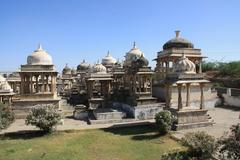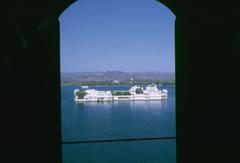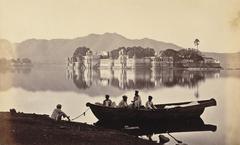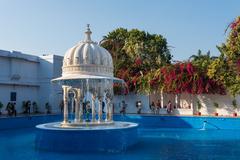Sajjangarh Wildlife Sanctuary Visiting Hours, Tickets, and History
Date: 23/07/2024
Introduction
Nestled in the picturesque Aravalli hills of Udaipur, Rajasthan, the Sajjangarh Wildlife Sanctuary offers a unique blend of historical significance, ecological diversity, and cultural heritage. Established in 1987, the sanctuary spans approximately 5.19 square kilometers and is named after the Sajjangarh Palace, also known as the Monsoon Palace, built by Maharana Sajjan Singh in 1884 (Rajasthan Tourism). Originally intended as an astronomical center and a summer retreat for the royal family, the palace now stands as a testament to the region’s rich cultural heritage and commitment to wildlife conservation. The sanctuary itself is a biodiversity hotspot, home to a variety of plant and animal species, including leopards, hyenas, and numerous bird species (Wildlife Institute of India). This guide provides a comprehensive overview of the sanctuary’s history, visitor information, travel tips, and conservation efforts, making it an essential read for anyone planning a visit to this remarkable site.
Table of Contents
- [Introduction](#introductionintroduction)
- [History of Sajjangarh Wildlife Sanctuary](#history-of-sajjangarh-wildlife-sanctuaryhistory-of-sajjangarh-wildlife-sanctuary)
- [Establishment and Early History](#establishment-and-early-historyestablishment-and-early-history)
- [Royal Patronage and Conservation Efforts](#royal-patronage-and-conservation-effortsroyal-patronage-and-conservation-efforts)
- [Flora and Fauna](#flora-and-faunaflora-and-fauna)
- [Historical Significance of the Monsoon Palace](#historical-significance-of-the-monsoon-palacehistorical-significance-of-the-monsoon-palace)
- [Modern-Day Conservation Efforts](#modern-day-conservation-effortsmodern-day-conservation-efforts)
- [Visitor Information](#visitor-informationvisitor-information)
- [Tickets and Visiting Hours](#tickets-and-visiting-hourstickets-and-visiting-hours)
- [Travel Tips](#travel-tipstravel-tips)
- [Community Involvement and Eco-Tourism](#community-involvement-and-eco-tourismcommunity-involvement-and-eco-tourism)
- [Challenges and Future Prospects](#challenges-and-future-prospectschallenges-and-future-prospects)
- [FAQ](#faqfaq)
- [Conclusion](#conclusionconclusion)
- [References](#referencesreferences)
History of Sajjangarh Wildlife Sanctuary
Establishment and Early History
Sajjangarh Wildlife Sanctuary, located in Udaipur, Rajasthan, India, is a testament to the region’s rich history and commitment to wildlife conservation. The sanctuary was established in 1987, covering an area of approximately 5.19 square kilometers. It is named after the Sajjangarh Palace, also known as the Monsoon Palace, which was built by Maharana Sajjan Singh in 1884. The palace was originally intended to serve as an astronomical center and a monsoon retreat for the royal family, offering panoramic views of the surrounding countryside and the city of Udaipur.
Royal Patronage and Conservation Efforts
The establishment of the sanctuary was part of a broader initiative by the royal family of Mewar to preserve the natural habitat and wildlife of the region. Maharana Sajjan Singh, a visionary ruler, was deeply committed to environmental conservation. His efforts laid the groundwork for the sanctuary, which aimed to protect the diverse flora and fauna of the Aravalli hills. The sanctuary’s creation was a significant step in safeguarding the region’s ecological balance and promoting sustainable tourism.
Flora and Fauna
The sanctuary is home to a variety of plant and animal species, making it a biodiversity hotspot. The vegetation primarily consists of dry deciduous forests, with species such as Dhok (Anogeissus pendula), Salar (Boswellia serrata), and Khair (Acacia catechu). The sanctuary also boasts a rich avian population, including species like the Grey Junglefowl, Peafowl, and various migratory birds.
The fauna of Sajjangarh Wildlife Sanctuary includes several mammals, reptiles, and amphibians. Notable species include the Panther, Hyena, Jackal, and Hare. The sanctuary also provides a habitat for reptiles such as the Monitor Lizard and various snake species. The presence of these diverse species underscores the sanctuary’s importance as a conservation area.
Historical Significance of the Monsoon Palace
The Monsoon Palace, perched atop the Bansdara Peak at an elevation of 944 meters, is a significant historical landmark within the sanctuary. The palace was constructed using white marble and features intricate Rajput architecture. It was designed to track the monsoon clouds and serve as a summer retreat for the royal family. The palace’s strategic location offers breathtaking views of the Fateh Sagar Lake, the city of Udaipur, and the surrounding Aravalli hills.
The Monsoon Palace played a crucial role in the region’s history, serving as a symbol of the Mewar dynasty’s architectural prowess and their connection to nature. The palace’s construction was a remarkable feat, considering the challenging terrain and the limited technological resources available at the time. Today, the palace stands as a testament to the region’s rich cultural heritage and attracts numerous tourists and history enthusiasts.
Modern-Day Conservation Efforts
In recent years, the Rajasthan Forest Department has undertaken several initiatives to enhance the sanctuary’s conservation efforts. These initiatives include habitat restoration, anti-poaching measures, and community engagement programs. The department has also focused on improving the sanctuary’s infrastructure to facilitate eco-tourism and provide visitors with an immersive experience.
One of the key conservation projects in the sanctuary is the reforestation of degraded areas. This involves planting native tree species to restore the natural habitat and provide food and shelter for the wildlife. The department also conducts regular wildlife surveys and monitoring to track the population dynamics of various species and assess the effectiveness of conservation measures.
Visitor Information
Tickets and Visiting Hours
- Visiting Hours: The sanctuary is open to visitors from 9:00 AM to 5:00 PM every day.
- Ticket Prices: The entry fee for Indian nationals is INR 30, and for foreign nationals, it is INR 300. Additional charges may apply for camera usage and guided tours.
Travel Tips
- Best Time to Visit: The ideal time to visit the sanctuary is between October and March when the weather is pleasant and wildlife sightings are more frequent.
- Nearby Attractions: While in Udaipur, you can also explore nearby attractions such as the City Palace, Lake Pichola, and Jagdish Temple.
- Accessibility: The sanctuary is easily accessible by road from Udaipur city center. Public transportation and private taxis are readily available.
Community Involvement and Eco-Tourism
Community involvement is a crucial aspect of the sanctuary’s conservation strategy. The Rajasthan Forest Department collaborates with local communities to promote sustainable livelihoods and reduce human-wildlife conflicts. This includes providing training and support for eco-tourism initiatives, such as guided nature walks, bird watching tours, and wildlife photography workshops.
Eco-tourism plays a vital role in generating revenue for the sanctuary and raising awareness about the importance of wildlife conservation. The sanctuary offers several eco-friendly accommodations, including forest rest houses and campsites, allowing visitors to experience the natural beauty of the region while minimizing their environmental impact.
Challenges and Future Prospects
Despite the significant progress made in conservation efforts, the sanctuary faces several challenges. These include habitat fragmentation, human encroachment, and the threat of poaching. Climate change also poses a significant risk, affecting the availability of water and altering the habitat conditions for various species.
To address these challenges, the Rajasthan Forest Department is exploring innovative conservation strategies, such as the use of technology for wildlife monitoring and the implementation of community-based conservation programs. The department is also working on expanding the sanctuary’s protected area and establishing wildlife corridors to facilitate the movement of animals and reduce the risk of human-wildlife conflicts.
FAQ
Q: What are the visiting hours for Sajjangarh Wildlife Sanctuary?
A: The sanctuary is open from 9:00 AM to 5:00 PM every day.
Q: How much are the tickets for visiting the sanctuary?
A: The entry fee is INR 30 for Indian nationals and INR 300 for foreign nationals. Additional charges may apply for camera usage and guided tours.
Q: What is the best time to visit Sajjangarh Wildlife Sanctuary?
A: The best time to visit is between October and March.
Q: Are there any guided tours available?
A: Yes, the sanctuary offers guided tours and nature walks.
Q: What are some nearby attractions?
A: Nearby attractions include the City Palace, Lake Pichola, and Jagdish Temple.
Conclusion
Sajjangarh Wildlife Sanctuary is not just a sanctuary for wildlife enthusiasts; it is a living testament to Rajasthan’s rich cultural and ecological heritage. From its establishment in 1987 to its ongoing conservation efforts, the sanctuary plays a crucial role in preserving the natural habitat and promoting sustainable tourism. The Monsoon Palace, a significant historical landmark within the sanctuary, adds to its allure, drawing tourists and history enthusiasts from around the world (Lonely Planet). Despite facing challenges like habitat degradation and climate change, the sanctuary continues to thrive through innovative conservation strategies and community involvement. By visiting Sajjangarh Wildlife Sanctuary, you contribute to its conservation efforts and immerse yourself in the rich history and natural beauty of Udaipur. For more information, follow us on social media for the latest updates and travel tips.
References
- Rajasthan Tourism, 2024, Rajasthan Tourism Department https://www.tourism.rajasthan.gov.in
- Wildlife Institute of India, 2024, Wildlife Institute of India https://wii.gov.in
- Lonely Planet, 2024, Lonely Planet https://www.lonelyplanet.com



